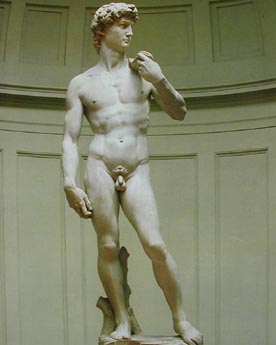

michelangelo The david marble statue standing at 4.34m/14 ft 3 in tall
Clck for large high quality photo's of Michelangelo's David.


Michelangelo David
Gigantic marble, started in 1501 and completed in 1504
Michelangelo began work on the colossal figure of David in 1501, and
by 1504 the sculpture (standing at 4.34m/14 ft 3 in tall) was in place outside
the Palazzo Vecchio. The choice of David was supposed to reflect the power and
determination of Republican Florence and was under constant attack from supporters
of the usurped Medicis. In the 19th century the statue was moved to the Academe.
There is a full size copy of the statue in the piazza, the original moved to
safely after a "woman" berating her husband tossed a chair from a
window overlooking the piazza, and one of the arms of the statue received collateral
damaged, and fell to the ground with the chair, silence fell over the square.......
Michelangelo: a dominant force in Florence and Rome
Michelangelo Buonarroti (1475-1564) exerted enormous influence. He, too, was
universally acknowledged as a supreme artist in his own lifetime, but again,
his followers all too often present us with only the master's outward manner,
his muscularity and gigantic grandeur; they miss the inspiration. Sebastiano
del Piombo (c.1485-1547), for example, actually used a drawing (at least a sketch)
made for him by Michelangelo for his masterwork, The Raising of Lazarus. Masterwork
it is; yet how melodramatic it appears if compared with Michelangelo's own painting.
Michelangelo resisted the paintbrush, vowing with his characteristic vehemence that his sole tool was the chisel. As a well-born Florentine, a member of the minor aristocracy, he was temperamentally resistant to coercion at any time. Only the power of the pope, tyranical by position and by nature, forced him to the Sistine and the reluctant achievement of the world's greatest single fresco. His contemporaries spoke about his terribilità, which means, of course, not so much being terrible as being awesome. There has never been a more literally awesome artist than Michelangelo: awesome in the scope of his imagination, awesome in his awareness of the significance--the spiritual significance--of beauty. Beauty was to him divine, one of the ways God communicated Himself to humanity.
Like Leonardo, Michelangelo too had a good Florentine teacher, the delightful Domenico Ghirlandaio (c.1448-94). Later, he was to claim that he never had a teacher, and figuratively, this is a meaningful enough statement. However, his handling of the claw chisel does reveal his debt to Ghirlandaio's early influence, and this is evident in the cross-hatching of Michelangelo's drawings--a technique he undoubtedly learned from his master. The gentle accomplishments of a work like The Birth of John the Baptist bear not the slightest resemblance to the huge intelligence of an early work of Michelangelo's like The Holy Family, also known as the Doni Tondo. This is somehow not an attractive picture with its chilly, remote beauty, but its stark power stays in the mind when more acessible paintings have been forgotten.